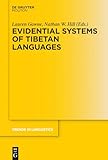Evidential Systems of Tibetan Languages / ed. by Nathan W. Hill, Lauren Gawne.
Material type: TextSeries: Trends in Linguistics. Studies and Monographs [TiLSM] ; 302Publisher: Berlin ; Boston : De Gruyter Mouton, [2017]Copyright date: ©2017Description: 1 online resource (VI, 472 p.)Content type:
TextSeries: Trends in Linguistics. Studies and Monographs [TiLSM] ; 302Publisher: Berlin ; Boston : De Gruyter Mouton, [2017]Copyright date: ©2017Description: 1 online resource (VI, 472 p.)Content type: - 9783110460186
- 9783110471878
- 9783110473742
- 495.4 23
- PL3551
- online - DeGruyter
- Issued also in print.
| Item type | Current library | Call number | URL | Status | Notes | Barcode | |
|---|---|---|---|---|---|---|---|
 eBook
eBook
|
Biblioteca "Angelicum" Pont. Univ. S.Tommaso d'Aquino Nuvola online | online - DeGruyter (Browse shelf(Opens below)) | Online access | Not for loan (Accesso limitato) | Accesso per gli utenti autorizzati / Access for authorized users | (dgr)9783110473742 |
Frontmatter -- Contents -- 1 The contribution of Tibetan languages to the study of evidentiality -- Typology and history -- 2 Evidentiality of the Tibetan verb snang -- 3 Egophoric evidentiality in Bodish languages -- 4 A typological sketch of evidential/epistemic categories in the Tibetic languages -- 5 Perfect experiential constructions: the inferential semantics of direct evidence -- 6 On the origin of the Lhasa Tibetan evidentials song and byung -- Lhasa and Diasporic Tibetan -- 7 Lhasa Tibetan predicates -- 8 Inference and deferred evidence in Tibetan -- Other Tibetan languages -- 9 Evidentiality in Purik Tibetan -- 10 Copulas in Denjongke or Sikkimese Bhutia -- 11 An overview of some epistemic categories in Dzongkha -- 12 Observations on factors affecting the distributional properties of evidential markers in Amdo Tibetan -- 13 The evidential system of Zhollam Tibetan -- 14 Evidentials in Pingwu Baima -- Index
restricted access online access with authorization star
http://purl.org/coar/access_right/c_16ec
This edited volume brings together work on the evidential systems ofTibetan languages. This includes diachronic research, synchronicdescription of systems in individual Tibetan varieties and papersaddressing broader theoretical or typological questions. Evidentiality inTibetan languages interacts with other features of modality,interactional context and speaker knowledge states in ways that provideimportant perspectives for typologists and our general understanding ofevidential systems. This book provides the first sustained attempt tocapture this complexity and diversity from both a synchronic anddiachronic perspective.
Issued also in print.
Mode of access: Internet via World Wide Web.
In English.
Description based on online resource; title from PDF title page (publisher's Web site, viewed 25. Jun 2024)


